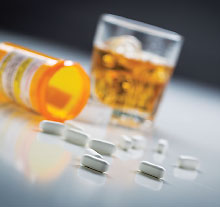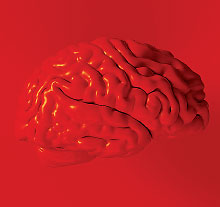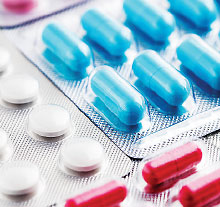Journal Digest: Tic Disorders; Infrared Therapy; SGA; Weight Stigma; TBT
Tic Disorders Associated With Increased Substance Misuse Risks

People with Tourette syndrome or another chronic tic disorder (TS/CTD) have an elevated risk of adverse substance use outcomes, independent of any other psychiatric disorders they have. These findings were published in Biological Psychiatry.
Researchers at the University of Helsinki and colleagues analyzed Swedish registry data and identified 7,832 individuals who had received a diagnosis of TS/CTD between 1973 and 2013. Compared with Swedes with no TS/CTD, those with TS/CTD were about three times as likely to have an adverse substance misuse outcome. An adverse substance misuse outcome was defined as a diagnosis of an alcohol or drug use disorder, a substance-related criminal conviction, or substance-related death.
Among the various adverse substance misuse outcomes, the highest risk was for a diagnosis of a drug use disorder (such as cannabis or stimulant use disorder); individuals with TS/CTD were almost seven times as likely than those without TS/CTD to have a drug use disorder.
Seventy-one percent of the individuals with TS/CTD had at least one other psychiatric comorbidity, but the researchers found that excluding people with comorbidities had negligible effects on adverse substance misuse outcomes. The one psychiatric illness that did impact the risk of adverse substance misuse outcomes was attention-deficit/hyperactivity disorder (ADHD); however, individuals with TS/CTD who did not have ADHD still had about four times the risk of a drug use disorder and twice the risk of any adverse substance misuse outcome compared with people without TS/CTD.
“[I]t is important to note that the majority of individuals with TS/CTD do not have substance misuse problems, and that a TS/CTD diagnosis should not be automatically equated with problematic alcohol or drug use,” the researchers wrote. However, screening for drug and alcohol use should become part of the standard clinical routine for patients with TS/CTD, particularly those with comorbid ADHD.
Suvi Virtanen S, Sidorchuk A, Fernández de la Cruz L, et al. Association of Tourette Syndrome and Chronic Tic Disorder With Subsequent Risk of Alcohol- or Drug-Related Disorders, Criminal Convictions, and Death: A Population-Based Family Study. Biol Psychiatry. September 21, 2020. [Online ahead of print]
Infrared Light Therapy Might Help Speed Recovery From TBI

A pilot study by investigators at Harvard Medical School and colleagues suggests low-level infrared light therapy may be a safe and feasible approach for treating patients with traumatic brain injury (TBI). The study, which was published in JAMA Network Open, also demonstrated that infrared light therapy resulted in neurological changes.
The investigators assigned 68 adults who had experienced a moderate TBI within the last 72 hours to receive either infrared or sham light therapy. The light therapy involved three 20-minute sessions with a special helmet spaced about 12 hours apart. Of the 68 enrollees, 28 completed at least one light therapy session and 18 completed all three sessions. All participants received MRI scans before the first light therapy session and at follow-ups two to three weeks and three months later.
There were no adverse effects associated with the light therapy helmet or the stimulation process, according to an analysis of physician reports and patient interviews. An analysis of the MRI scans showed that patients who received infrared therapy showed greater neuroactivity in their damaged white matter than those receiving sham therapy; this suggests that the infrared therapy stimulates the repair of myelin, the insulation that sheathes neurons.
The patients who received infrared therapy also reported greater reductions in their TBI symptoms at follow-up visits than those receiving sham therapy, but due to the small sample, the investigators did not find any statistical difference between the groups.
“This study provides the first human evidence to date that light therapy engages neural substrates that play a role in the pathophysiologic factors of moderate TBI and also suggests diffusion imaging as the biomarker of therapeutic response,” the authors concluded.
Figueiro Longo MG, Tan CO, Chan ST et al. Effect of Transcranial Low-Level Light Therapy vs Sham Therapy Among Patients With Moderate Traumatic Brain Injury: A Randomized Clinical Trial. JAMA Netw Open. 2020; 3(9): e2017337
Augmenting With SGA Increases Risk of Death in Some Patients

Previous studies suggest the use of antipsychotics can increase the risk of death in elderly patients with dementia. A study in PLoS One has now found evidence to suggest that augmenting an antidepressant with a second-generation antipsychotic (SGA) may also increase the risk of death in nonelderly patients with depression relative to augmenting with a second antidepressant. The greatest mortality risks were among patients ages 55 to 64, women, and patients augmented with olanzapine or risperidone.
“Although the absolute mortality risk in patients with depression is markedly lower than in elderly patients with dementia, the magnitude of excess risk in the nonelderly depression group is substantial and warrants careful clinical consideration,” the study investigators wrote.
The investigators from Rutgers University and colleagues analyzed Medicaid claims data from 2001 to 2010 to identify patients aged 25 to 64 with depression who had been taking an antidepressant for at least three months before augmentation with an SGA or a second antidepressant.
The final sample included 39,582 adults, of whom 22,410 were augmented with an antipsychotic (most taking either quetiapine, risperidone, aripiprazole, or olanzapine); and 17,172 were augmented with another antidepressant. The patients were tracked for 365 days or until discontinuation of the augmenting agent, loss of Medicaid, or death—whichever came first.
During the follow-up period, 105 patients in the antipsychotic group and 48 patients in the second antidepressant group died. After adjusting for other variables, the investigators estimated a 45% increased mortality risk for antipsychotic augmentation. The risk was primarily attributed to natural deaths, as there was no statistical difference between the two augmentation groups when looking only at unnatural deaths such as accident, suicide, or homicide.
Gerhard T, Stroup TS, Correll CU et al. Mortality Risk of Antipsychotic Augmentation for Adult Depression. PLoS One. 2020; 15(9): e0239206.
Weight Stigma Linked to Depression, Binge Eating in Youth During Pandemic

Young adults who had been teased about their weight prior to the COVID-19 pandemic may be at higher risk of depression and binge eating during the pandemic. The findings were published in the Annals of Behavioral Medicine.
“Understanding whether weight stigma elevates risk for health challenges during the pandemic represents a critical first step for the development of health messaging, responses, and support during outbreaks of COVID-19 and similar public health emergencies,” the investigators wrote. They added that weight stigma carries particular importance during the current crisis given that obesity is one of the biggest risk factors for COVID-19 complications.
The researchers from the University of Connecticut and the University of Minnesota used data from a follow-up survey of 584 young adults (average age of 24) who had been enrolled in a long-term study from 2010 to 2018 assessing the eating and physical activity habits of youth. The survey included questions on how eating behaviors, physical activity, and perceived stress or depression changed for the participants following the COVID-19 outbreak.
The 43% of respondents who reported being teased about their weight at the conclusion of the original study in 2018 were more likely to report depressive symptoms, stress, and eating as a coping strategy compared with young adults who had never been teased about their weight. Young adults who experienced stigma were also nearly three times as likely to engage in binge eating during the early months of the pandemic.
“While high BMI may be a risk factor for complications of COVID-19, it is important to consider how to effectively communicate about links between body weight and COVID-19 since messages that induce shame or stigma about weight may contribute to and reinforce adverse health consequences,” the authors concluded.
Puhl RM, Lessard LM, Larson N, et al. Weight Stigma as a Predictor of Distress and Maladaptive Eating Behaviors During COVID-19: Longitudinal Findings From the EAT Study. Ann Behav Med. September 10, 2020. [Online ahead of print]
Anxious Teens May Benefit From TBT

Transdiagnostic behavior therapy (TBT) is an approach that combines elements of multiple disorder-specific psychotherapies to treat people with co-occurring affective disorders, such as depression and anxiety. Most studies of TBT have focused on adults, but a report in the American Journal of Psychotherapy suggests that group TBT can be effective for adolescents.
Investigators at Canada’s McMaster University enrolled 20 adolescents aged 16 to 19 to receive 12 120-minute sessions of group TBT. All the participants had an anxiety disorder as a primary diagnosis (including panic disorder, social anxiety disorder, generalized anxiety disorder, and posttraumatic stress disorder) and comorbid depression or anxiety.
The group TBT was based on an adult TBT protocol but adapted for teens by incorporating coping strategies earlier in the treatment and adding a session on self-esteem.
After 12 weeks, the average scores for both cognitive (worrying thoughts) and somatic (dizziness) anxiety symptoms dropped significantly among the adolescents, as did their stress levels, as indicated by the State-Trait Inventory for Cognitive and Somatic Anxiety. In contrast, depression scores did not change significantly following the group TBT sessions. “[I]t is possible that our participants experienced less severe comorbid symptoms and related impairment compared with adult samples, thus limiting potential treatment gains in these areas,” the authors wrote. “It also is possible that this treatment was simply less effective for depressive symptoms in this population.”
Nonetheless, the authors suggested TBT is a promising approach for youth that warrants further studies, such as randomized trials as well as studies in which depression is the primary diagnosis. ■
Gros DF, Merrifield C, Hewitt J, et al. Preliminary Findings for Group Transdiagnostic Behavior Therapy for Affective Disorders Among Youths. Am J Psychother. August 26, 2020. [Online ahead of print]



